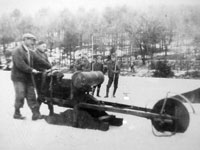New York State Civilian Conservation Corps Museum

In the aftermath of the Great Depression, the federal government developed many programs designed to ease unemployment and put people back to work. The Civilian Conservation Corps (CCC) was one of these federal programs and this site was created as an introduction to the significant role the Corps played in the development of New York State's Gilbert Lake State Park. From 1933 to 1941, CCC Company 212, SP-11, lived and worked at Gilbert Lake. Those unfamiliar with the park should read the 1,300-word essay about Gilbert Lake and its accompanying 1,400-word essay, History of the CCC at Gilbert Lake, about the contribution of the CCC to the park.
The center of this otherwise simple exhibit is the more than 150 photographs. They include pictures of young men swimming in the lake, enjoying sack races, and building the camp. Visitors will also find recent photographs of the camp, including a 1999 restoration project of one of the park's cabin. The site is rounded out by three donated letters from people with memories about the CCC at Gilbert Lake and those interested will find the 40-item bibliography useful.